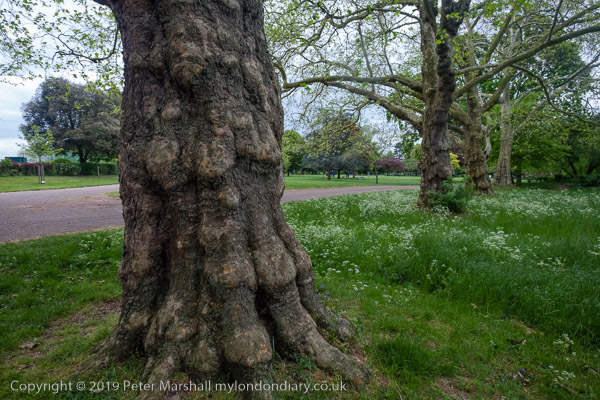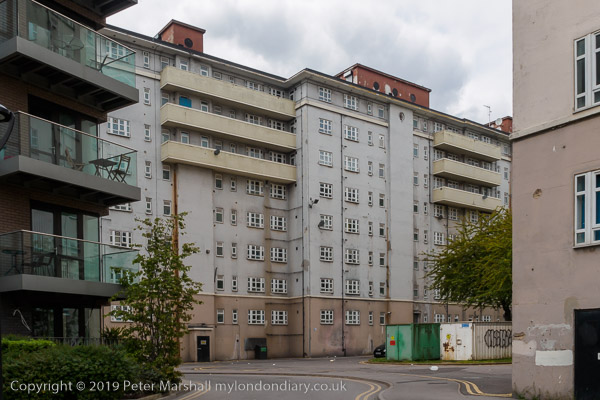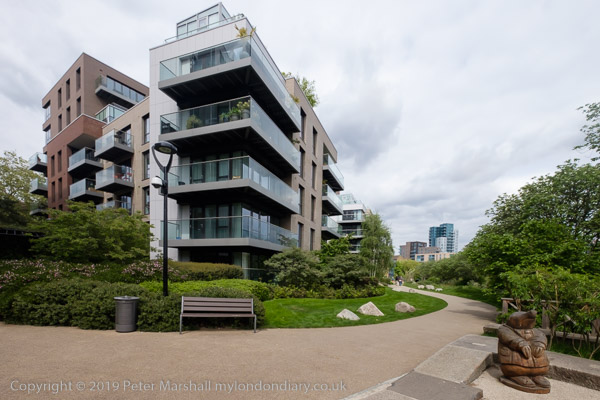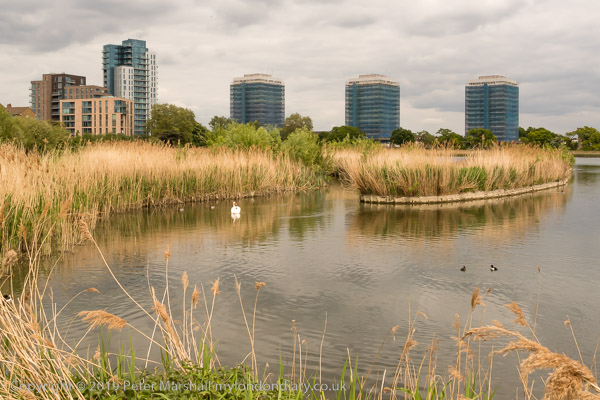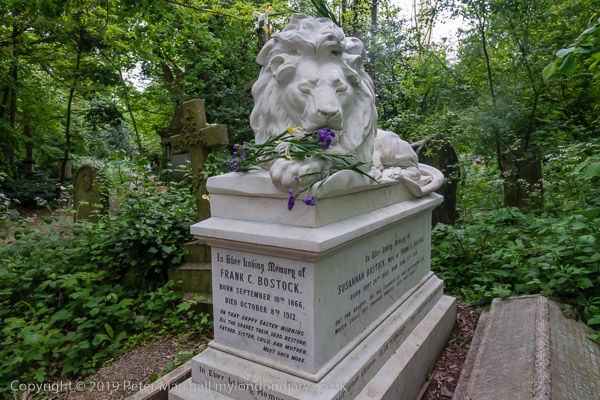A Reservoir, Flats, a Cockerel and a Café: More from my walk in Highgate on Sunday 19th November. You can read the previous part at Churches, Flats, Houses & a Pineapple – Highgate 1989
Beyond these large red-brick buildings that line the north side of Hornsey Lane is the grass covered reservoir built by the New River Company and just beyond that across Tile Kiln Lane is their Engine House dating from around 1859. Now called the Pump House the site includes the base of a large chimney for a steam-driven pump. This reservoir and pump and others in the area became necessary as higher areas in Hampstead and Highgate were developed. The locally listed building has more recently been converted to residential use.
A few yards further east I crossed the Archway Bridge, where perhaps surprisingly I didn’t take any pictures of the view down the road. I did take three photographs of one of the ornamental lamposts but haven’t digitised any of these. The two at the east end seem rather similar to some of those on the Thames embankment with entwined fish swimming around them. About 5 years ago the fairly low ornamental fence on each side of the bridge has been augmented with a tall metal fence to prevent people jumping to their death on the road below.
Further east of the bridge is Northwood Hall, an art deco block built as “ultra modern labour-saving” luxury flats in 1935 and designed in a cross shape by George Edward Bright who had earlier worked as an assistant to Herbert Baker, Edwin Lutyens and Guy Dawber. The almost 200 flats were set in extensive gardens with “a restaurant for residents, guest rooms and outdoor amenities including a tennis court. Indoors, there were uniformed porters available 24/7 and an optional maids’ service charged at hourly rates. In kitchens, double door cupboards opening onto the corridors were used to provide additional services including rubbish collection, shoe cleaning and delivery of papers, food and even cooked meals.”
Sat on a hill overlooking London the residents on all but its ground floor have extensive views across London ‘on a clear day as far as Crystal Palace‘ and the building is a landmark visible from much of north London.
This sculpture was commission by and paid for by the architect of the LCC’s Ashmount School, H.T. Cadbury-Brown. Built in 1954-6 it was an important early example of an all-glass curtain wall construction.
The cockerel now stands on top of the wall outside the Whitehall Park School, built on part of the Ashmount site with the rest being used for housing.
Advertising for Nautilus Fitness and Tree Surgery on Crouch End Hill, immediately south of the former Crouch End Station – where the old track is now the Parkland Walk. I wondered what the large letters BSG on the wall stood for but could come up with no sensible solution. I think the picture is looking down Stroud Green Road.
The Crescent Café was in part of the former Crouch End Station buildings. A Cafe continues here – with a name change to Sercem Cafe for a couple of years before going back to being Crescent Cafe again until around 2021-2 and is now Merro. The station probably dates from when the line opened in 1867; the station closed in 1954 but goods traffic along the line continued until 1970.
The Café was closed on the Sunday I took this picture. At right you can see one of the tall brick pillars on top a a curved wall that go beside and across the bridge across the former railway. I’d photographed the cafe and these twelve years earlier but hadn’t put the wall picture online.
I turned north up Crouch End Hill and photographed another mansion block, Monkridge, just a few yards further on. This was apparently built between 1912 and 1935 with around 40 flats and a lower building. The two blocks are very similar in design with this being slightly large actually on Crouch End Hill and the other behind on Haslemere Road.
The final post on this walk will follow shortly.
Flickr – Facebook – My London Diary – Hull Photos – Lea Valley – Paris
London’s Industrial Heritage – London Photos
All photographs on this page are copyright © Peter Marshall.
Contact me to buy prints or licence to reproduce.







